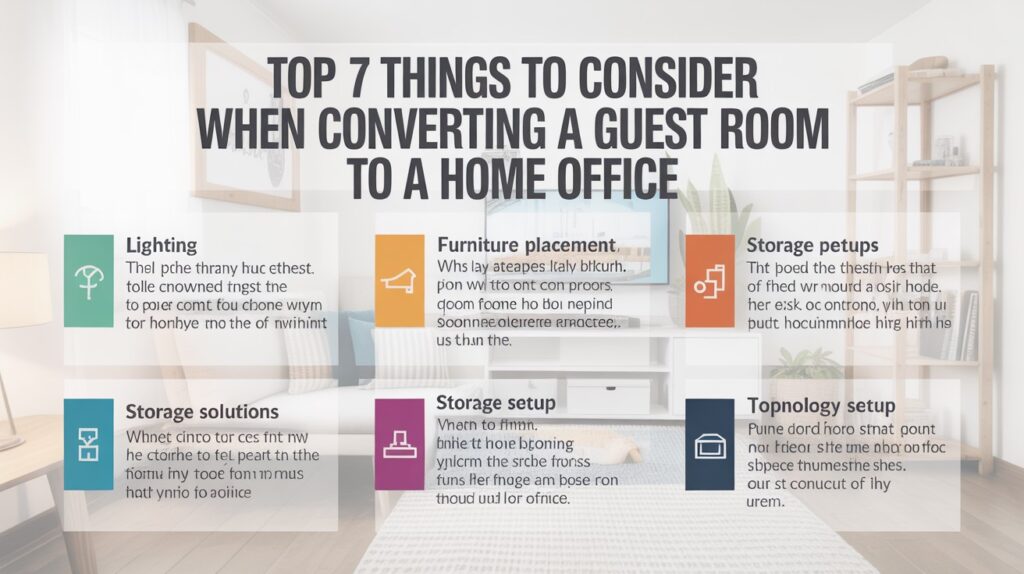Turning a spare room into a workspace can be a game-changer for productivity and focus. Whether you’re running a small business or working remotely, a home office offers much-needed privacy and structure. But transforming a guest room into something truly functional takes more than a desk and chair. It’s about tailoring the space to suit your work habits and home environment.
In practice, that might mean reworking insulation, adding power outlets, or adjusting the layout to reduce noise. Homeowners in Otago often turn to professional Mosgiel builders for this kind of targeted renovation, especially when compliance and long-term value are part of the equation.
If you’re considering a similar upgrade, it pays to think through the details before you start knocking down walls or rearranging furniture. Here are seven practical considerations to guide your guest room conversion into a workspace that truly works.
Your Space and Its Limitations
You’ve cleared out the spare bed and stacked boxes in the hallway, but now what? Before turning that room into your dream workspace, it’s worth evaluating what you’re working with. How large is the room? Does it get natural light? Where are the power outlets? Understanding these small yet practical details will guide every decision that follows.
Some rooms may need additional electrical outlets or insulation, while others might only need minimal changes. Consulting local contractors can help identify structural possibilities before the work begins, ensuring upgrades function smoothly while also meeting safety and quality standards.
Comfort and Function
Comfort matters more than many realise, especially when your workspace becomes a daily destination. Ergonomic furniture, such as an adjustable chair and a desk at the right height, helps prevent strain and fatigue. But physical ease goes beyond seating. Good airflow and temperature control are also essential in keeping your mind clear and your body relaxed.
Think of comfort as an investment in your efficiency rather than a luxury. When your workspace supports your physical needs, it becomes easier to stay engaged and maintain momentum throughout the day.
Lighting Quality
Natural light can elevate a home office instantly, improving both alertness and overall well-being. If your guest room has windows, position your desk nearby, but watch for glare on screens during midday hours. In dimmer spaces, combine ambient lighting with task lamps that target your work area. This layered approach helps reduce eye strain and promotes mental clarity throughout the day.
Storage and Organisation
Picture this: you’ve set up your workstation perfectly, but by week three, papers, cables, and coffee mugs have claimed every surface. Clutter builds quickly, and it’s a quiet drain on focus and productivity. Built-in shelves, rolling drawers, or vertical storage solutions can help maintain order without compromising style.
There are countless ways to approach storage, but in all cases, you’ll need to think about accessibility. Keep essentials within reach and store less-used items out of sight. A thoughtfully organised space isn’t just tidy; it’s intuitive.
Soundproofing and Privacy
Even the most beautifully designed office won’t help much if you’re constantly distracted by noise. Whether it’s traffic, kids, or the neighbour’s lawnmower, unwanted sounds can derail your concentration. To reduce noise, consider weather stripping, acoustic panels, or thick rugs that absorb sound. If you share the home, upgrading to a solid-core door can make a noticeable difference. Each fix helps create more privacy and deeper focus, allowing you to complete tasks faster and with less stress.
Professional Yet Personal Design
A home office should feel inviting, but it also needs to look the part, especially if video calls are part of your daily routine. Neutral tones, organised shelves, and good lighting create a clean, camera-friendly backdrop. These elements signal professionalism without feeling dull.
That doesn’t mean the space has to be boring. A favourite art print, a plant, or a textured rug can add warmth and personality without overwhelming the room. When your workspace reflects both your style and your standards, it becomes easier to feel motivated and ready to dive in.
Flexibility for the Future
Your work situation today might not be the same in a year. Maybe your role evolves, or you start sharing the space with a partner or child. Designing with flexibility in mind helps you stay ahead of those shifts. Modular furniture, portable lighting, and multipurpose layouts can adapt easily to changing needs. Even something as simple as a fold-out guest bed can keep the room versatile without disrupting your setup. Whatever styles or moods you prefer, make sure your workspace effortlessly meets you, wherever you are in life.
Design a Home Office You’ll Love to Work In
Transforming a spare room into a productivity hub is about more than aesthetics. It’s about blending thoughtful design with functional upgrades to create an environment that helps you focus and feel inspired. Start the process by considering these factors and how each one can support your goals and lifestyle. The work may take time and effort, but the results will be worth it. When your home office works for you, showing up and staying motivated becomes second nature.

